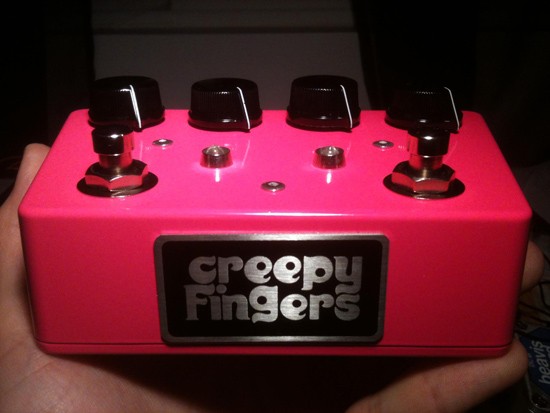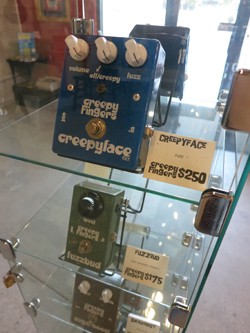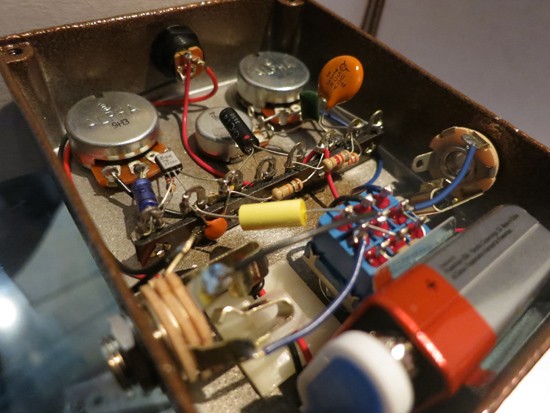
When the OC stoner rock band Fu Manchu began twenty years ago, the world of effects pedals consisted of a few rusty ones leftover from the 1970s waiting to be stumbled upon at random pawn shops. But today, even that world has become dominated by mass-market brands such as Boss and DigiTech that sell distortion and fuzz just as McDonalds does hamburgers.
Fu Manchu's bassist Brad Davis, however, is part of a growing number of new pedal builders who are hand-soldering a range of effects products unlike anything the '90s ever dreamed about. Based out of Davis' Fullerton garage, his company Creepy Fingers is one of the few locally-based contributors in this growing world of boutique, small-batch music gear–producing knob-filled models with names like Fuzzbud, Sugarboost and Doomidrive.
Long Beach's specialty music store Dawn of the Shred—the subject of this week's feature story–is the only brick-and-mortar in Southern California that carries Creepy Fingers, which made sense when we discovered that Davis was the impetus for opening the business in the first place.
]
“Dealing with Brad is the reason I got into this,” Dawn of the Shred owner James Demetra says. “At the time, not a lot of people were doing the types of pedals he makes. So I asked him, 'If I'm gonna get this pedal, how many do I have to get to become a dealer?'”
We sat down with Davis at Dawn of the Shred while he was dropping off a recent shipment of pedals (which consisted of a Trader Joe's bag filled with his handmade wares) to talk about his hobby-turned-full-time-whenever-Fu-Manchu-isn't-on-tour job, the perils of buying transistors on eBay and how his pedals became popular with everyone from Billy Gibbons of ZZ Top to Erykah Badu's guitarist.

OC Weekly (Sarah Bennett): How did you first get into effects pedals?
Brad Davis: Ever since playing guitar I've been interested in guitars and pedals and distortion. I had a little battery operated Peavey amp that had a distortion option which I thought was insane. But playing in Fu Manchu, specifically, I got really interested in fuzz pedals. Especially when eBay showed up–then you wouldn't have to dig through pawn shops for them.
How did purchasing them turn into making them?
At a certain point I was spending a lot of money on pedals and I couldn't stop. I had stumbled on Build Your Own Clone [buildyourownclone.com], which makes kits for people starting out. At first you just build what's in the kit but after a while you get interested in what makes it sound the way it does. There are a lot of resources out there and I basically learned everything from the Internet and insomnia. It was like college.
What was the first Creepy Fingers pedal?
The first one I built that was a prototype for a future Creepy Fingers pedal was the Sugarboost and I'm pretty sure that has a date as 2006. As I started expanding the lineup into different effects, Bob [Balch of Fu Manchu] started using them. He has the first official Creepy Fingers pedal I ever made.
What other retail outlets you sell to besides Dawn of the Shred?
I've got stores in Seattle, New Jersey, Berkeley and Vegas that carry Creepy Fingers. At this point, I'm hitting the point of production where I can barely keep up. It's a good stress because you're in charge and I've been lucky because I haven't needed advertising or search out distributors.
Do you think your success is based on the reputation of Fu Manchu or the pedals themselves?
It gives some people a reference point for my products, but at this point, it's the pedals, themselves. In the last couple of years, it's morphed into people that have heard other people use them or seen videos of them online. Again, the Internet is really good for that. You can learn a lot about a pedal before you buy one these days without actually playing through it.
Isn't that problematic though, you never really can tell what it'll sound like until you get it on your own rig?
Well, there's definitely not as much buyer's remorse when you get to play through it in person. An all-signal chain can really change the way a pedal sounds. Like with the Doomidrive — it's not a fuzz pedal or distortion. When people listen to a sample of it, it's a product of the guitar I'm using, the output of the pickups and the preamp section of the amp. The pedal's not distorting itself, it's forcing the amp to do the distortion, so a lot does rely on stuff you can't show online.

I heard you use a lot of new old stock, too. How do you find enough vintage parts to keep up production?
I'm trying to phase that out because it's pricey and so popular now — it's like Mad Max out there where you have to battle all these other people seeking the same components. But I have a pretty large stock of certain transistors that go with certain pedals I build like the Creepyface, which uses these transistors that were originally built for the military in the 1960s. I bought a bunch of them from some guy in Canada and they come in these little envelopes that you tear open and they haven't touched air since 1966. They sound really good.
Do people ever try and fake the new old stock?
Yeah, whenever somebody sees that there's a certain transistor that people are starting to sell a lot, it's fair game for counterfeiting. I was sold some counterfeit transistors on eBay not too long ago. If he had sent me some decent ones, I might not have been able to tell. But they were leaky and hissy. Plus, the second I got them, I put them under the light and I could see something was wrong. People are scraping off the logos on newer transistors and stamping them with homemade stamps for the more coveted branded ones, but this guy did a poor job and you could still see the original markings. I got my money back, of course, but that was the most ridiculous person I've ever dealt with on eBay.
Follow us on twitter at @OCWeeklyMusic and like us on Facebook at Heard Mentality.
Sarah Bennett is a freelance journalist who has spent nearly a decade covering food, music, craft beer, arts, culture and all sorts of bizarro things that interest her for local, regional and national publications.

